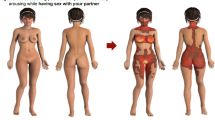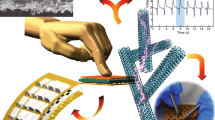Abstract
The sense of touch is believed to provide a reliable perception of the object’s properties; however, our tactile perceptions could be illusory at times. A recently reported tactile illusion shows that a raised form can be perceived as indented when it is surrounded by textured areas. This phenomenon suggests that the form perception can be influenced by the surface textures in its adjacent areas. As perception of texture and that of form have been studied independently of each other, the present study examined whether textures, in addition to the geometric edges, contribute to the tactile form perception. We examined the perception of the flat and raised contact surface (3.0 mm width) with various heights (0.1, 0.2, 0.3 mm), which had either textured or non-textured adjacent areas, under the static, passive and active touch conditions. Our results showed that texture decreased the raised perception of the surface with a small height (0.1 mm) and decreased the flat perception of the physically flat surface under the passive and active touch conditions. We discuss a possible mechanism underlying the effect of the textures on the form perception based on previous neurophysiological findings.


Similar content being viewed by others
References
Bhushan B (2002) Introduction to tribology. Wiley, New York
Blake R, Sekuler R (2006) Perception. McGraw Hill Higher Education, New York
Blake DT, Hsiao SS, Johnson KO (1997) Neural coding mechanisms in tactile pattern recognition: the relative contributions of slowly and rapidly adapting mechanoreceptors to perceived roughness. J Neurosci 17:7480–7489
Connor CE, Johnson KO (1992) Neural coding of tactile texture: comparison of spatial and temporal mechanisms for roughness perception. J Neurosci 12:3414–3426
Connor CE, Hsiao SS, Phillips JR, Johnson KO (1990) Tactile roughness: neural codes that account for psychophysical magnitude estimates. J Neurosci 10:3823–3826
Hayward V, Cruz-Hernandez M (2000) Tactile display device using distributed lateral skin stretch. In Proc. of the Haptic Interfaces for Virtual Environ and Teleop Sys Symp DSC-69-2: 1309–1314
Hollins M, Risner SR (2000) Evidence for the duplex theory of tactile texture perception. Percept Psychophys 62:695–705
Johnson KO, Hsiao SS (1992) Neural mechanisms of tactual form and texture perception. Annu Rev Neurosci 15:227–250
Johnson KO, Phillips JR (1981) Tactile spatial resolution. I. Two-point discrimination, gap detection, grating resolution, and letter recognition. J Neurophysiol 46:1177–1192
Johnson KO, Yoshioka T, Vega–Bermudez F (2000) Tactile functions of mechanoreceptive afferents innervating the hand. J Clin Neurophysiol 17:539–558
Klatzky RL, Lederman SJ (1993) Toward a computational model of constraint-driven exploration and haptic object identification. Percept 22:597–621
Lederman SJ, Taylor MM (1972) Fingertip force, surface geometry, and the perception of roughness by active touch. Percep & Psychophys 12:401–408
Miyaoka T, Mano T, Ohka M (1999) Mechanisms of fine-surface-texture discrimination in human tactile sensation. J Acoust Soc Am 105:2485–2492
Nakatani M, Howe RD, Tachi S (2006) The Fishbone Tactile Illusion. Proc of Eurohaptics 69–73
Phillips JR, Johnson KO (1981) Tactile spatial resolution. II. Neural representation of Bars, edges, and gratings in monkey primary afferents. J Neurophysiol 46:1192–1203
Srinivasan MA, Whitehouse JM, LaMotte RH (1990) actile detection of slip: surface microgeometry and peripheral neural codes. J Neurophysiol 63:1323–1332
Vega-Bermudez F, Johnson KO, Hsiao SS (1991) Human tactile pattern recognition: active versus passive touch, velocity effects, and patterns of confusion. J Neurophysiol 65:531–546
Acknowledgments
We would like to thank Ai Koizumi for her comments on the earlier drafts. The authors also thank María Oyarzábal, Christopher R. Wagner, Ryan A. Beasley and Douglas P. Perrin for their insightful discussions.
Author information
Authors and Affiliations
Corresponding author
Rights and permissions
About this article
Cite this article
Nakatani, M., Howe, R.D. & Tachi, S. Surface texture can bias tactile form perception. Exp Brain Res 208, 151–156 (2011). https://doi.org/10.1007/s00221-010-2464-3
Received:
Accepted:
Published:
Issue Date:
DOI: https://doi.org/10.1007/s00221-010-2464-3




